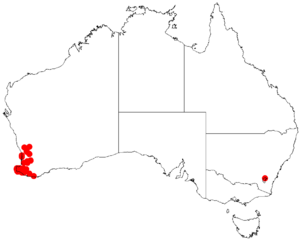Acacia gilbertii facts for kids
Quick facts for kids Acacia gilbertii |
|
|---|---|
| Scientific classification | |
| Genus: |
Acacia
|
| Species: |
gilbertii
|
 |
|
| Occurrence data from AVH | |
Acacia gilbertii is a special kind of shrub. It belongs to the Acacia family, which is also known as the wattle family. This plant is found only in a specific part of Western Australia, meaning it is endemic there.
What Does Acacia gilbertii Look Like?
This plant is an upright, slender shrub. It usually grows to be about 0.3 to 1.5 metres (1 to 5 ft) tall. Its branches are smooth, meaning they don't have any hairs.
The leaves of Acacia gilbertii are quite interesting. They are made up of one or two pairs of smaller leaf sections called pinnae. These sections are 1.5 to 4 cm (0.59 to 1.57 in) long. Each pinna has three to seven pairs of even smaller leaflets called pinnules. These pinnules are light green. When new ones grow, they often have a reddish color. They are shaped like narrow oblongs or ellipses. Each pinnule is about 8 to 20 mm (0.31 to 0.79 in) long and 3 to 5 mm (0.12 to 0.20 in) wide.
The shrub blooms from October to February. During this time, it produces pretty white flowers.
How Was Acacia gilbertii Named?
The way plants are named and classified is called Taxonomy. Acacia gilbertii was first officially described by a botanist named Carl Meisner. He did this in 1848. His description was part of a larger work called Plantae Preissianae.
Later, in 2003, another botanist named Leslie Pedley reclassified it. He moved it to a different genus, calling it Racosperma gilbertii. However, in 2006, it was moved back to the Acacia genus. So, its official name today is Acacia gilbertii.
Where Does Acacia gilbertii Grow?
This shrub is native to the south western part of Australia. It grows in specific areas within the Wheatbelt and South West regions of Western Australia. You can often find it growing in gravelly soils that contain laterite.
Acacia gilbertii is spread out in different locations. It can be found from around York in the north. Its range extends south to places like Augusta. It also reaches out towards Denmark in the south east. This plant typically grows as part of Eucalyptus woodlands. It is also found in forests where Eucalyptus marginata trees are common.

